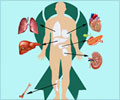A severe form of of seasonal influenza world-wide affects 3-5 million people and 250-500,000 die from complications on an annual basis.
A severe form of of seasonal influenza world-wide affects 3-5 million people and 250-500,000 die from complications on an annual basis. The emergence of the novel 2009 H1N1 (nH1N1) influenza has complicated the scenario this year.
Since novel 2009 H1N1 is a viral infection of the respiratory tract, there are additional challenges for cardiopulmonary transplant recipients and donors, as well as for the healthcare workers involved in the transplant process. In an article published online today in the Journal of Heart and Lung Transplantation, physicians representing the International Society for Heart & Lung Transplantation (ISHLT) Infectious Disease Council issue an advisory for all programs in cardiothoracic transplantation.Mandeep R. Mehra, MBBS, FACC, FACP, Editor-in-Chief, the Journal of Heart and Lung Transplantation observes, "Nowhere is the threat of H1N1 more real than in cardiopulmonary transplantation. The ISHLT's Infectious Disease Council has developed what is assuredly the most comprehensive and clinically relevant direction for prevention and management of H1N1 flu in donors, recipients, care providers and family members."
Recognition of the novel 2009 H1N1 influenza virus, aggressive diagnosis and early treatment need be paired with active preventative measures to stem the impact of infection in the transplant population. This special advisory addresses issues relevant to cardiothoracic transplant candidates, selection of donors, recipient management and patients with mechanical circulatory support devices. Since transplant recipients are treated with anti-rejection drugs, the advisory provides clear directions for specific dosing of antiviral drugs and management of the background immunosuppression. Specific guidelines for evaluation and management of post-surgical transplant patients are also given, as well as recommendations for how and when to administer vaccines. On the donor side, the advisory provides guidelines for how to evaluate and treat donors so that organs can be safely used and not wasted. Finally, it provides specific guidelines for the healthcare teams managing such patients.
Writing in the article, Lara A. Danziger-Isakov MD MPH, Cleveland Clinic Children's Hospital, states, "Interaction with organ procurement organizations for organ selection must take into account emerging data on the use of organs from patients infected and treated for the novel 2009 H1N1 Influenza virus. Improved diagnostic testing with shorter turnaround times is needed in donor evaluation. Individual patient education, prevention measures and treatment strategies will also require attention to the local patterns of infection, availability of the novel 2009 H1N1 Influenza virus vaccination, and emerging patterns of antiviral resistance. Finally, efforts to contain and prevent the novel 2009 H1N1 Influenza virus from spreading within the cardiothoracic transplant setting can be accomplished through infection control measures."
"This article is an initiative of the Infectious Disease (ID) council of ISHLT to provide timely practical guidance for cardiothoracic transplant programs facing a winter pandemic of novel 2009 H1N1 influenza," comments Dr Margaret M Hannan, Mater Misericordiae University Hospital, Dublin, Chairman of ID council for ISHLT. "Evolving diagnostic testing with limitations due to prolonged turnaround time and availability are considered in donor and recipient management. Ensuring that the most accurate diagnostic tests are being carried out in a timely and systematic manner will allow cardiothoracic transplant surgeons to make informed decisions in 'real time' and avoid waste of usable organs." Education of staff and patients in infection control and prevention is fundamental to successful management of this virus in the transplant recipient population.
Advertisement
RAS










